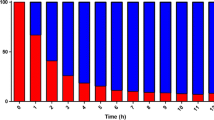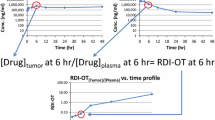Abstract
In vivo microdialysis technique has become one of the major tools to sample endogenous and exogenous substances in extracellular spaces. As a well-validated sampling technique, microdialysis has been frequently employed for quantifying drug disposition at the desired target in both preclinical and clinical settings. This review addresses general methodological considerations critical to performing microdialysis in tumors, highlights selected preclinical and clinical studies that characterized drug disposition in tumors by the use of microdialysis, and illustrates the potential application of microdialysis in the assessment of tumor response to cancer treatment.
Similar content being viewed by others
References
Galmarini CM, Galmarini FC. Multidrug resistance in cancer therapy: role of the microenvironment.Curr Opin Investig Drugs. 2003;4:1416–1421.
Hryniuk WM. The importance of dose intensity in the outcome of chemotherapy. In:Important Adv Oncol. 1988:121–141.
Masson E, Zamboni WC. PK optimisation of cancer chemotherapy: effect on outcomes.Clin Pharmacokinet. 1997;32:324–343.
Yuan F. Transvascular drug delivery in solid tumors.Semin Radiat Oncol. 1998;8:164–175.
Jain RK. Delivery of molecular and cellular medicine to solid tumors.Adv Drug Deliv Rev., 2001;46:149–168.
Tong RT, Boucher Y, Kozin SV, Winkler F, Hicklin DJ, Jain RK. Vascular normalization by vascular endothelial growth factor receptor 2 blockade induces a pressure gradient across the vasculature and improves drug penetration in tumors.Cancer Res. 2004;64:3731–3736.
Müller M, Mader RM, Steiner B, et al. 5-fluorouracil kinetics in the interstitial tumor space: clinical response in breast cancer patients.Cancer Res. 1997;57:2598–2601.
Hunz M, Jetter A, Wilde S, et al. Plasma and tissue PKs of epirubicin in nine patients with primary breast cancer.Eur J Clin Pharmacol. 2001;57:A31.
Garimella TS, Ross DD, Eiseman JL, et al. Plasma PKs and tissue distribution of the breast cancer resistance protein (BCRP/ABCG2) inhibitor fumitremorgin C in SCID mice bearing T8 tumors.Cancer Chemother Pharmacol. 2005;55:101–109.
Meikle SR, Matthews JC, Brock CS, et al. PK assessment of novel anti-cancer drugs using spectral analysis and positron emission tomography: a feasibility study.Cancer Chemother Pharmacol. 1998;42:183–193.
Fischman AJ, Alpert NM, Babich JW, Rubin RH. The role of positron emission tomography in PK analysis.Drug Metab Rev. 1997;29:923–956.
Jynge P, Skjetne T, Gribbestad I, et al., In vivo tissue PKs by fluorine magnetic resonance spectroscopy: a study of liver and muscle disposition of fleroxacin in humans.Clin Pharmacol Ther. 1990;48:481–489.
Artemov D, Solaiyappan M, Bhujwalla ZM. Magnetic resonance pharmacoangiography to detect and predict chemotherapy delivery to solid tumors.Cancer Res. 2001;61:3039–3044.
Benveniste H, Huttemeier PC. Microdialysis—theory and application.Prog Neurobiol. 1990;35:195–215.
Ungerstedt U. Microdialysis—principles and applications for studies in animals and man.J Intern Med. 1991;230:365–373.
Benveniste H. Brain microdialysis.J Neurochem. 1989;52:1667–1679.
Elmquist WF, Sawchuk RJ. Application of microdialysis in PK studies.Pharm Res. 1997;14:267–288.
Garrison KE, Pasas SA, Cooper JD, Davies MI. A review of membrane sampling from biological tissues with applications in PKs, metabolism and PDs.Eur J Pharm Sci. 2002;17:1–12.
Chu J, Gallo JM. Application of microdialysis to characterize drug disposition in tumors.Adv Drug Deliv Rev. 2000;45:243–253.
Mader RM, Schrolnberger C, Rizovski B, et al. Penetration of capecitabine and its metabolites into malignant and healthy tissues of patients with advanced breast cancer.Br J Cancer. 2003;88:782–787.
Brunner M, Muller M. Microdialysis: an in vivo approach for measuring drug delivery in oncology.Eur J Clin Pharmacol. 2002;58:227–234.
Johnson RD, Justice JB. Model studies for brain dialysis.Brain Res Bull. 1983;10:567–571.
Ungerstedt U. Measurement of transmitter release by intracerebral dialysis. In: Marsden CA, ed.Measurement of Neurotransmitter Release In Vivo. Chichester, UK: John Wiley & Sons; 1984:81–105.
Ståhle L. On mathematical models of microdialysis: geometry, steady-state models, recovery and probe radius.Adv Drug Deliv Rev. 2000;45:149–167.
Lönnroth P, Jansson P, Smith U. A microdialysis method allowing characterization of intercellular water space in humans.Am J Physiol. 1987;253:E228-E231.
Ståhle L. Drug distribution studies with microdialysis. I. Tissue dependent difference in recovery between caffeine and theophylline.Life Sci. 1991;49:1835–1842.
Larsson CI. The use of an “internal standard” for control of the recovery in microdialysis.Life Sci. 1991;49:PL73-PL78.
Menacherry S Jr, Hubert W Jr. Justice JB Jr. In vivo calibration of microdialysis probes for exogenous compounds.Anal Chem 1992;64:577–583.
Yokel RA, Allen DD, Burgio DE, McNamara PJ. Antipyrine as a dialyzable reference to correct differences in efficiency among and within sampling devices during in vivo microdialysis.J Pharmacol Toxicol Methods. 1992;27:135–142.
Van Belle K, Dzeka T, Sarre S, Ebinger G, Michotte Y. In vitro and in vivo microdialysis calibration for the measurement of carbamazepine and its metabolites in rat brain tissue using the internal reference technique.J Neurosci Methods 1993;49:167–173.
Wang Y, Wong SL, Sawchuk RJ. Microdialysis calibration using retrodialysis and zero-net flux: application to a study of the distribution of zidovudine to rabbit cerebrospinal fluid and thalamus.Pharm Res. 1993;10:1411–1419.
Le Quellec A, Dupin S, Genissel P, Saivin S, Marchand B, Houin G. Microdialysis probes calibration: gradient and tissue dependent changes in no net flux and reverse dialysis methods.J Pharmacol Toxicol Methods. 1995;33:11–16.
Clement R, Malinovsky JM, Dollo G, Le Corre P, Chevanne F, Le Verge R. In vitro and in vivo microdialysis calibration using retrodialysis for the study of the cerebrospinal distribution of bupivacaine.J Pharm Biomed Anal 1998;17:665–670.
Ståhle L. Drug distribution studies with microdialysis. I. Tissue dependent difference in recovery between caffeine and theophylline.Life Sci. 1991;49:1835–1842.
Stenken JA. Methods and issues in microdialysis calibration.Anal Chim Acta. 1999;379:337–358.
Chaurasia CS. In vivo microdialysis sampling: theory and applications.Biomed Chromatogr. 1999;13:317–332.
Jacobson I, Sandberg M, Hamberger A. Mass transfer in brain dialysis devices—a new method for the estimation of extracellular amino acids concentration.J Neurosci Methods. 1985;15:263–268.
Trickler WJ, Miller DW. Use of osmotic agents in microdialysis studies to improve the recovery of macromolecules.J Pharm Sci. 2003;92:1419–1427.
Dabrosin C, Margetts PJ, Gauldie J. Estradiol increases extracellular levels of vascular endothelial growth factor in vivo in murine mammary cancer.Int J Cancer. 2003;107:535–540.
Sjogren F, Svensson C, Anderson C. Technical prerequisites for in vivo microdialysis determination of interleukin-6 in human dermis.Br J Dermatol. 2002;146:375–382.
Rosdahl H, Ungerstedt U, Henriksson J. Microdialysis in human skeletal muscle and adipose tissue at low flow rates is possible if dextran-70 is added to prevent loss of perfusion fluid.Acta Physiol Scand. 1997;159:261–262.
Ault JM, Riley CM, Meltzer NM, Lunte CE. Dermal microdialysis sampling in vivo.Pharm Res. 1994;11:1631–1639.
Davies MI, Lunte CE. Microdialysis sampling for hepatic metabolism studies: impact of microdialysis probe design and implantation technique on liver tissue.Drug Metab Dispos. 1995;23:1072–1079.
Palsmeier RK, Lunte CE. Microdialysis sampling of tumors for study of the metabolism of antineoplastic agents.Cancer Bull. 1994;46:58–66.
Westergren I, Nystrom B, Hamberger A, Johansson BB. Intracerebral dialysis and the blood-brain barrier.J Neurochem. 1995;64:229–234.
Morgan ME, Singhal D, Anderson BD. Quantitative assessment of blood-brain barrier damage during microdialysis.J Pharmacol Exp Ther. 1996;277:1167–1176.
Groothuis DR, Ward S, Schlageter KE, et al. Changes in blood-brain barrier permeability associated with insertion of brain cannulas and microdialysis probes.Brain Res. 1998;803:218–230.
Joukhadar C, Klein N, Mader RM, et al. Penetration of dacarbazine and its active metabolite 5-aminoimidazole-4-carboxamide into cutaneous metastases of human malignant melanoma.Cancer. 2001;92:2190–2196.
Johansen MJ, Thapar N, Newman RA, Madden T. Use of microdialysis to study platinum anticancer agent PKs in preclinical models.J Exp Ther Oncol. 2002;2:163–173.
Zamboni WC, Gervais AC, Egorin MJ, et al. Inter- and intratumoral disposition of platinum in solid tumors after administration of cisplatin.Clin Cancer Res. 2002;8:2992–2999.
Dukic SF, Kaltenbach ML, Heurtaux T, Hoizey G, Lallemand A, Vistelle R. Influence of C6 and CNS1 brain tumors on methotrexate PKs in plasma and brain tissue.J Neurooncol. 2004;67:131–138.
Leggas M, Zhuang Y, Welden J, Self Z, Waters CM, Stewart CF. Microbore HPLC method with online microdialysis for measurement of topotecan lactone and carboxylate in murine CitCSF.J Pharm Sci. 2004;93:2284–2295.
Tokunaga Y, Nakashima M, Sasaki H, et al. Local distribution into brain tumor and PKs of 4-pyridoxate diammine hydroxy platinum, a novel cisplatin derivative, after intracarotid administration in rats with 9L malignant glioma: simultaneous brain microdialysis study.Biol Pharm Bull. 2000;23:1491–1496.
Zamboni WC, Gervais AC, Egorin MJ, et al. Systemic and tumor disposition of platinum after administration of cisplatin or STEALTH liposomal-cisplatin formulations (SPI-077 and SPI-077 B103) in a preclinical tumors model of melanoma.Cancer Chemother Pharmacol. 2004;53:329–336.
Ma J, Pulfer S, Li S, Chu J, Reed K, Gallo JM. PD-mediated reduction of temozolomide tumor concentrations by the angiogenesis inhibitor TNP-470.Cancer Res. 2001;61:5491–5498.
Ma J, Li S, Reed K, Guo P, Gallo JM. PD-mediated effects of the angiogenesis inhibitor SU5416 on the tumor disposition of temozolomide in subcutaneous and intracerebral glioma xenograft models.J Pharmacol Exp Ther. 2003;305:833–839.
Harrington KJ, Lewanski CR, Northcote AD, et al. Phase I–II study of pegylated liposomal cisplatin (SPI-077) in patients with inoperable head and neck cancer.Ann Oncol. 2001;12:493–496.
Devineni D, Klein-Szanto A, Gallo JM. In vivo microdialysis to characterize drug transport in brain tumors: analysis of methotrexate uptake in rat glioma-2 (RG-2)-bearing rats.Cancer Chemother Pharmacol. 1996;38:499–507.
Devineni D, Klein-Szanto A, Gallo JM. Uptake of temozolomide in a rat glioma model in the presence and absence of the angiogenesis inhibitor TNP-470.Cancer Res. 1996;56:1983–1987.
Teicher BA, Dupuis NP, Robinson MF, Emi Y, Goff DA. Antiangiogenic treatment (TNP-470/minocycline) increases tissue levels of anticancer drugs in mice bearing Lewis lung carcinoma.Oncol Res. 1995;7:237–243.
Tegeder I, Brautigam L, Seegel M, et al. Cisplatin tumor concentrations after intra-arterial cisplatin infusion or embolization in patients with oral cancer.Clin Pharmacol Ther. 2003;73:417–426.
Joukhadar C, Klein N, Mader RM, et al. Penetration of dacarbazine and its active metabolite 5-aminoimidazole-4-carboxamide into cutaneous metastases of human malignant melanoma.Cancer. 2001;92:2190–2196.
Ekstrom PO, Andersen A, Saeter G, Giercksky KE, Slordal L. Continuous intratumoral microdialysis during high-dose methotrexate therapy in a patient with malignant fibrous histiocytoma of the femur: a case report.Cancer Chemother Pharmacol. 1997;39:267–272.
Müller M, Brunner M, Schmid R, et al. Intestitials methotrexate kinetics in primary breast cancer lesions.Cancer Res. 1998;58:2982–2985.
Schüller J, Cassidy J, Dumont E, et al. Preferential activation of capecitabine in tumor following oral administration to colorectal cancer patients.Cancer Chemother Pharmacol. 2000;45:291–297.
Abe R, Akiyoshi T, Baba T. Inactivation of cisdiamminedichloroplatinum (II) in blood by sodium thiosulfate.Oncology, 1990;47:65–69.
Zamboni WC, Houghton PJ, Hulstein JL, et al. Relationship between tumor extracellular fluid exposure to topotecan and tumor response in human neuroblastoma xenograft and cell lines.Cancer Chemother Pharmacol. 1999;43:269–276.
Gallo JM, Vicini P, Orlansky A, et al. PK model-predicted anticancer drug concentration in human tumors.Clin Cancer Res. 2004;10:8048–8058.
Castejon AM, Paez X, Hernandez L, Cubeddu LX. Use of intravenous microdialysis to monitor changes in serotonin release and metabolism induced by cisplatin in cancer patients: comparative effects of granisertron and ondansetron.J Pharmacol Exp Ther.1999;291:960–966.
Paez X, Hernandez L. Plasma serotonin monitoring by blood microdialysis coupled to high-performance liquid chromatography with electrochemical detection in humans.J Chromatogr B Biomed Sci Appl. 1998;720:33–38.
Garvin S, Dabrosin C. Tamoxifen inhibits secretion of vascular endothelial growth factor in breast cancer in vivo.Cancer Res. 2003;63:8742–8748.
Dabrosin C. Variability of vascular endothelial growth factor in normal human breast tissue in vivo during the menstrual cycle.J Clin Endocrinol Metab. 2003;88:2695–2698.
Author information
Authors and Affiliations
Corresponding author
Additional information
Published: October 24, 2005
Rights and permissions
About this article
Cite this article
Zhou, Q., Gallo, J.M. In vivo microdialysis for PK and PD studies of anticancer drugs. AAPS J 7, 66 (2005). https://doi.org/10.1208/aapsj070366
Received:
Accepted:
DOI: https://doi.org/10.1208/aapsj070366




